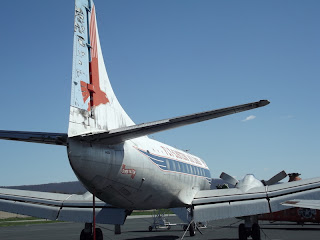A look at old jets, turboprops and prop driven aircraft. The checklists, manuals, systems, and equipment...everything that made them fly .
Monday, December 10, 2012
The Airport (1948)
Remember when flying was this easy....Chalk Boards, Handing the pilot a load manifest with a long pole....Great! Wgeb life was easy and simple.
Thursday, May 24, 2012
EASTERN AIRLINES MARTIN 404 WALK AROUND
EASTERN AIRLINES MARTIN 404
WALK AROUND
THIS AIRCRAFT IS ON THE RAMP AT MID ATLANTIC AIR MUSEUM
READING, PA. AIRPORT.
I TOOK A TRIP TO READING , PA. AIRPORT AND THE MID ATLANTIC AIR MUSEUM A FEW WEEKS AGO AND SPENT SOME TIME ON THE RAMP.
I TOOK A FEW PICTURES OF THIS OLD BIRD, ONE OF MY FAVORITES.
A BEAUTIFUL AIRCRAFT FROM THE ERA WHEN AIRLINE FLYING WAS A PLEASURE
| Crew: 3 or Capacity: 40 |
Length: 74 ft 7 in (22.73 m)
Wingspan: 93 ft 3 in (28.42 m)
Height: 28 ft 5 in (8.66 m)
Wing area: 864 ft2 (80.27 m2)
Empty weight: 29,126 lb (13,211 kg)
Gross weight: 44,900 lb (20,366 kg)
Powerplant: 2 × Pratt & Whitney R-2800-CB16 radial
piston engine, 2,400 hp (1,790 kW) each
Performance
Maximum speed: 312 mph (502 km/h)
Range: 1,080 miles (1,783 km)
Service ceiling: 29,000 ft (8,840 m)
First deliveries in 1951 were made to Eastern Air Lines (EAL)
who had ordered 60
EAL operated their 4-0-4s in the eastern USA
SURE MISS THESE OLD BIRDS.
 |
| PRATT AND WHITNEY R-2800 CB16 radial piston engine, 2,400 hp ONE OF THE BEST RECIPS EVER MADE. |
 |
| SIDE VIEWS |
 |
| HEAD ON |
 |
| LEFT STABILIZER ELEVATOR ELEVATOR TRIM TABS |
 |
| RIGHT ELEVATOR AND AFT FUSELAGE |
 |
| RIGHT WING FLAPS |
 |
| RIGHT MAIN GEAR STRUT AND REAR GEAR DOOR |
 |
| FLAP ACTUATOR FAIRING |
 |
| FLAP ACTUATOR FAIRING LOOKING TOWARD THE LEFT MAIN |
 |
| NACELLE WITH COWL FLAPS STUCK OPEN EXHAUST MANIFOLD |
 |
| FRONT VIEW OF NUMBER 1 NACELLE AND NOSE HUB |
 |
| UNDERSIDE LOOKING AFT |
 |
| NOSE GEAR WITH LANDING LIGHT |
 |
| VERTICAL STABILIZER IN ROUGH SHAPE |
 |
| A FAMILIAR LOGO |
 |
| TAIL STAND CONNECTION |
 |
| WHEN AIRLINERS WERE AIRLINERS |
 |
| LEFT REAR VIEW OF FLAPS |
 |
| A SCENE FROM THE PAST |
 |
| LEFT SIDE FUSELAGE AND CABIN WINDOWS |
 |
| LEFT MAIN TIRES AND HUB |
 |
| AUGMENTER EXHAUST TUBE |
Wednesday, May 9, 2012
A Strange Aircraft...The Custer Channel Wing
This is a little walk around of the Custer Channel Wing, sitting on the ramp at Mid Atlantic Air Museum at the Reading Pa. Airport.
The channel wing is an aircraft wing principle developed by Willard Ray Custer in the 1920s. The most important part of the wing consists of a half-tube with an engine placed in the middle, driving a propeller placed at the rear end of the channel formed by the half-tube.
A wing functions because the air over the wing has a lower pressure than the air under it. The conventional aircraft must reach a significant minimum speed before this pressure differential become large enough that it generates sufficient lift to become airborne.
In Custer's channel wing the rotating propeller will direct a stable stream of air backwards through the channel. A propeller will at the low pressure side normally be supplied by air from all directions. Since the half-tube prevents air from being drawn from below, the air will be sucked through the channel instead. This creates a strong low pressure area in the channel, which again generates a lift.
The old bird is in rough shape.
 |
| looking head on |
 |
| No.1 |
 |
| Cockpit |
 |
| No. 2 and right side |
 |
| Cockpit Throttle Pedestal |
Subscribe to:
Posts (Atom)











